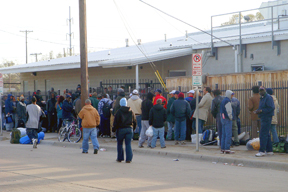 People wait in line on Cypress Street for their chance to be served a hot meal. Lee Chastain
People wait in line on Cypress Street for their chance to be served a hot meal. Lee Chastain
|
 The Presbyterian Night Shelter stays full, with residents sleeping on bunks and pads. Lee Chastain
The Presbyterian Night Shelter stays full, with residents sleeping on bunks and pads. Lee Chastain
|
|
A D V E R T I S E M E N T
|
|
|
|
A D V E R T I S E M E N T
|
|
Down for the Count
The city’s homeless plan is taking hold — but officials are bracing for the recession’s effects.
By Bryan Shettig
When city officials announced recently that a new census had shown fewer homeless people on Fort Worth streets, it sounded like good news on several fronts: good for homeless folks and maybe also for the city, which last year put in place an ambitious 10-year plan to end homelessness here.
Some are skeptical. Eastside activists say they aren’t seeing any big drop in panhandling or begging in their neighborhoods, and shelter workers say their facilities are still full. But even with a well-funded local plan and help from a $1.5 billion federal initiative recently announced by President Barack Obama, city officials and shelter workers fear that rising unemployment is going to once more swell the ranks of the homeless.
“The thing that we’re all nervous about is the state of the economy,” said Otis Thornton, coordinator for the mayor’s Advisory Commission on Homelessness.
The city adopted its long-range homeless plan last August, after activists complained that the city had no overall strategy for dealing with the issue. Although not everyone thinks the plan has had a major effect yet, results are starting to show.
The city set aside $3 million this fiscal year for the plan, which is known as Directions Home. That’s a major increase over the $119,000 that the city spent on homeless programs the previous year. Thus far, the plan has worked mostly to raise awareness of the problem, but more of the money is beginning to trickle out to shelters and other programs. The Presbyterian Night Shelter, for example, will receive a $111,000 grant to pay for two case managers, which spokeswoman Lyndsay Hoover said the shelter desperately needs, to provide more meaningful help to the people staying there.
“We’re still at capacity,” Hoover said. Presbyterian is Fort Worth’s largest shelter, with a capacity of just over 700 people.
Norman Bermes, a neighborhood activist, said he hasn’t noticed a decline in the number of homeless people loitering in Woodhaven, where he lives, but he still commends the city for its efforts. Bermes said neighborhood activists have been fighting homelessness by discouraging residents from giving money to panhandlers and warning them to be aware of loiterers and people who might threaten or follow them.
The census conducted last month showed that the number of homeless people across Tarrant County has continued to decline, continuing a trend of the last several years. The annual count — which includes Fort Worth, Arlington, and northeast Tarrant County — found about 2,200 homeless persons in the county this year compared to about 4,000 in 2007.
Officials from the city’s homeless coalition said that several factors are reducing the number of people on the street, chief among them the availability of permanent supportive housing. Those are housing arrangements in which formerly homeless people have access to medical and mental healthcare in addition to vocational training and regular visits from a case manager.
Multiple programs are operating locally to provide such housing. The idea is to get homeless people out of shelters and into housing with supervision that will keep them under a roof for good. “Slumlords aren’t getting these vouchers,” said Cindy J. Crain, executive director of the Tarrant County Homeless Coalition.
Project New Start, for instance, is run out of the Day Resource Center on Lancaster Avenue, paid for in part by grants from the U.S. Department of Housing and Urban Development and by private donations. For 14 years, the Fort Worth Housing Authority has run the federally funded Shelter Plus Care, which helps the disabled homeless find places to rent. The city of Fort Worth does not manage any supportive housing programs.
“It’s less expensive to put someone in housing than it is to leave them on the streets,” Thornton said. People living on the street use more medical resources, which end up being more expensive than rent, he said. He used the example of three homeless people who were treated at John Peter Smith Hospital two years ago and ran up combined medical bills of more than $500,000.
Few of the residences in the supportive housing program resemble the jumble of meager low-income apartments that neighborhood residents often fear will hurt their property values. The Villages at Samaritan House on Hemphill in south Fort Worth, which exclusively houses people who are HIV positive, has all the trappings of a modern complex: a washer and dryer in each unit, an icemaker in the fridge, and covered parking. At the end of the hall are on-site social services, including drug counseling.
Other housing is provided in a wide variety of apartments. Driving by, one would never know the people who live there used to be homeless. Thornton said part of the city’s new strategy is to have such housing more dispersed around the city.
Homeless people who work with case managers get rent vouchers. There are about 838 people in the city’s housing voucher program, and the places they stay must offer fair market rents and meet the same building codes as other complexes.
A longtime homeless woman, Sandra Johnson, who stays at the Salvation Army shelter, said homeless people often don’t know that seeing a case manager can help get them into housing. They are leery, she said, of starting new lives only to fall back into homelessness again through drugs, alcohol, or crime.
“These people have the talent — they just need opportunities,” she said.
According to a recent report by the Texas Workforce Commission, unemployment rates for Fort Worth and Arlington rose to 5.6 percent in December, up from 4.1 percent a year ago. That’s still below the state average of 6 percent. Homeless people do have options for work, however. Job training is available at the Eastside Workforce Center on East Lancaster Avenue and Workforce Solutions. Goodwill Industries hires disabled homeless people for staff jobs, Thornton said.
Obama last week said that about $1.5 billion in grants will be made available to homeless programs through the U.S. Department of Housing and Urban Development as part of the federal stimulus package. The money will give tax breaks to current and potential homeowners as well as access to rental deposits, and will provide utility payments to families in danger of losing their homes. How much of that will land in Fort Worth isn’t known yet.
A similar plan was started in Fort Worth in December. As part of its plan to address homelessness, the city gave the United Way about $1.5 million, which it in turn will give to agencies to help pay for case managers, substance abuse programs, and outreach services at the Salvation Army on East Lancaster, the Union Gospel Mission, and the Presbyterian Night Shelter.
“Fort Worth is stepping up to the plate and doing work for the first time in a long time,” Thornton said. “We just got serious about it.”
 Email this Article...
Email this Article...

